Port of Spain is the capital of Trinidad and Tobago. The city is known for its prosperous cultural heritage, which includes a mix of Creole, Indian, African, and European influences.
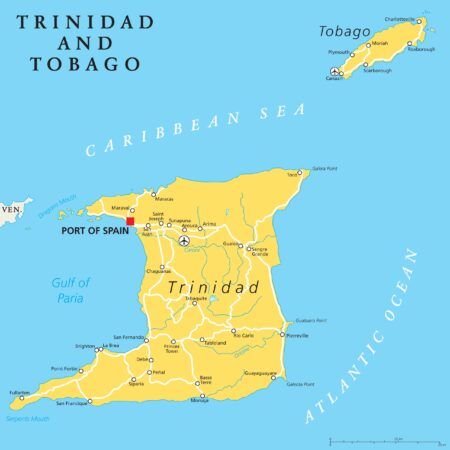
Port of Spain serves as the administrative and financial center of the country. It’s also a hub for the country’s famous Carnival celebrations. With a scenic backdrop of hills and a beautiful waterfront, the city offers a blend of modern skyscrapers and historical architecture.
Where is Port of Spain?
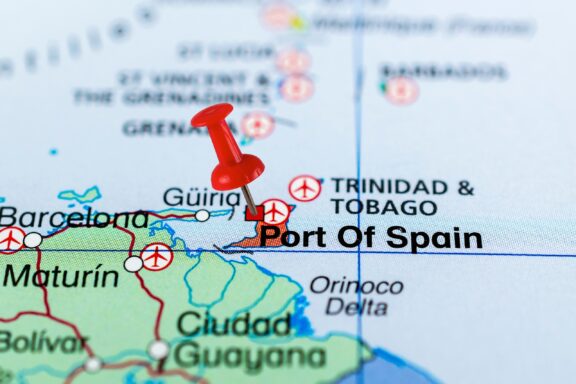
Port of Spain occupies the northwestern shoreline of Trinidad, the larger island in the Trinidad and Tobago duo. It nestles near the Gulf of Paria, a water body separating the island from Venezuela’s northeastern coast. In Trinidad, the city is in the northern region.
Framed by the sea to its north and the Northern Range hills to its south, Port of Spain boasts a picturesque landscape. Its geographical coordinates are roughly 10.6667 °N latitude and 61.5167 °W longitude.
This coastal city is a conduit to the Caribbean Sea via the Gulf of Paria. A mere 11 kilometers (about 7 miles) separate the town from Piarco Airport, a significant entry point to the country.
History of Port of Spain
Before the arrival of Europeans, the area was inhabited by indigenous peoples like the Arawaks and Caribs. When Spanish colonizers arrived in the late 15th and early 16th centuries, the settlement was not immediately prioritized for development.
The Spaniards focused more on other parts of their colonial empire. As a result, Port of Spain remained a relatively small and undeveloped fishing village for much of the Spanish colonial period.

Captured by the British in 1797, Port of Spain began to take on a new identity. The British colonial administrators invested in infrastructure, including roads and buildings, turning it into a thriving port.
The economic focus was on sugar and cocoa plantations, which required a significant labor force. Many iconic structures, such as the Queen’s Park Savannah and the Magnificent Seven Houses, were built during this time, reflecting the British architectural influence.
After the abolition of slavery in 1834, the city faced a labor shortage. To address this, indentured laborers were brought in from India and China.
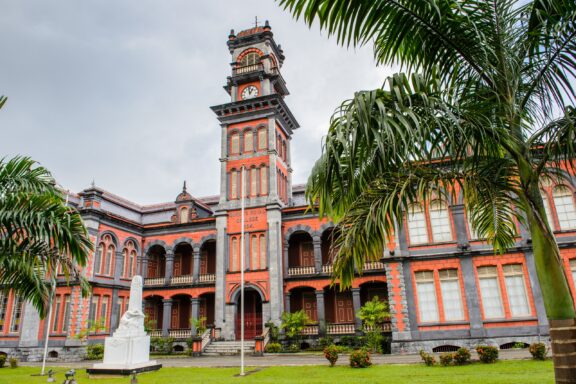
These new communities settled in and around Port of Spain, introducing their own cultural practices, languages, and cuisines, which enriched the city’s multicultural tapestry.
Later, during World War II, the presence of American military bases in the city brought American servicemen and resources. The U.S. presence also led to infrastructural improvements and boosted the local economy. The Americans also influenced popular culture, like music and fashion, adding another layer to the city’s diverse culture.
After Trinidad and Tobago gained independence on August 31, 1962, Port of Spain emerged as the political and administrative center of the newly independent nation of Trinidad and Tobago.
The city became home to crucial governmental institutions, including the parliament and the president’s residence. Modern buildings started to appear during this time, adding a contemporary touch to the cityscape.
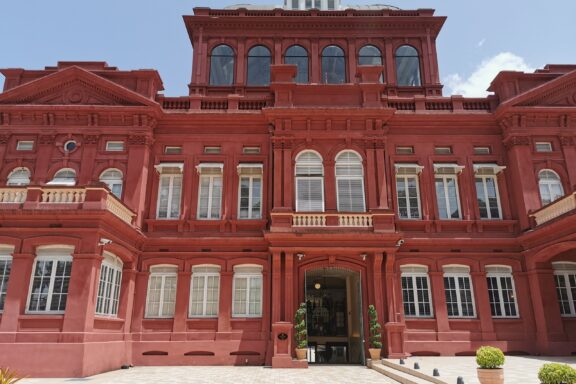
In the latter part of the 20th century and into the 21st, Port of Spain witnessed considerable economic growth, primarily due to the discovery of oil and natural gas.
By diving deeper into each period, we get a nuanced view of how Port of Spain has evolved over the years to become the complex and multifaceted city it is today.
Features of Port of Spain
Port of Spain is a city of contrasts and harmonies, where history and modernity coexist seamlessly. As you wander its streets, you’ll find architectural gems narrating colonial grandeur tales.
The city also serves as the political nerve center of Trinidad and Tobago, hosting important institutions and modern skyscrapers that signify the city’s role as a financial hub in the Caribbean, reflecting the economic prosperity driven by the oil and natural gas sectors.
Geography and Climate
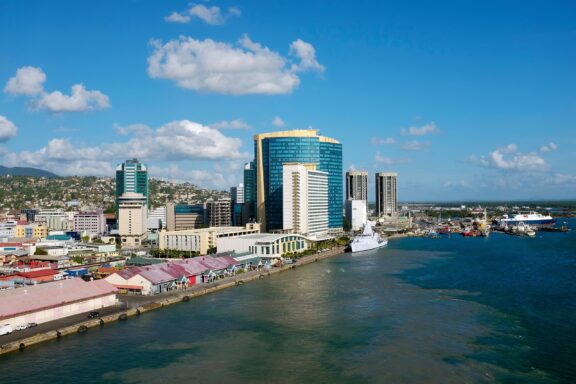
Port of Spain experiences a tropical rainforest climate, which
is warm and humid throughout the year. Rainfall is relatively consistent but tends to increase during the wet season, from June to December.
The city is flanked by the Northern Range hills to the south, providing a scenic backdrop and influencing local weather patterns, sometimes leading to cooler evenings.
Population
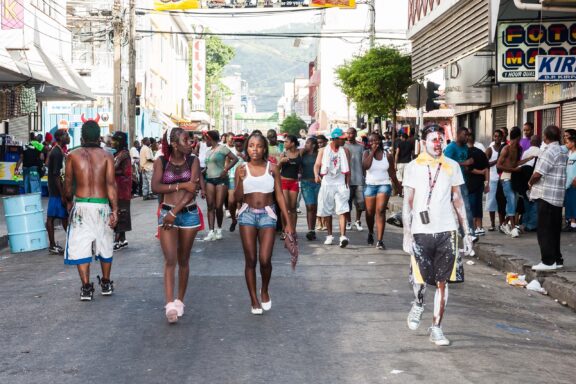
Port of Spain has a population that hovers around 40,000 residents within the city proper, but the metropolitan area considerably expands this number. It is a culturally diverse city, reflecting its complex history.
Descendants of African and Indian indentured laborers make up significant portions of the population, along with smaller communities of Europeans, Chinese, and Middle Eastern descent. English is the official language, but you can often hear a blend of languages and dialects, including Trinidadian Creole.
The city is a mosaic of various religious practices, with Hinduism, Islam, and Christianity being the most prominent.
Economy
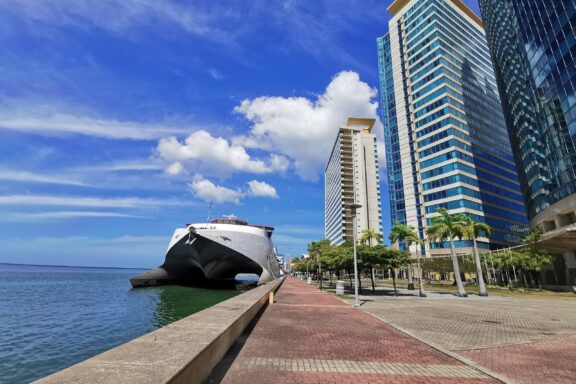
Port of Spain plays a crucial role in the economic landscape of Trinidad and Tobago. As the administrative and financial heart of the country, it is home to various ministries, governmental agencies, and foreign embassies.
The city is also a focal point for the energy sector, primarily oil and natural gas, which are critical drivers of the national economy. Numerous banks and financial services companies have headquarters here, making it a hub for commerce and investment in the Caribbean region.
Retail and tourism also contribute to the city’s economy, especially during the Carnival season, attracting visitors worldwide. The city is economically robust, serving as the linchpin for various industries and activities that fuel local and national growth.
Things to Do and Places to See in Port of Spain
Port of Spain offers a diverse array of activities and sights to explore. Let’s delve into some of the city’s most sought-after attractions and landmarks.
1. Queen’s Park Savannah
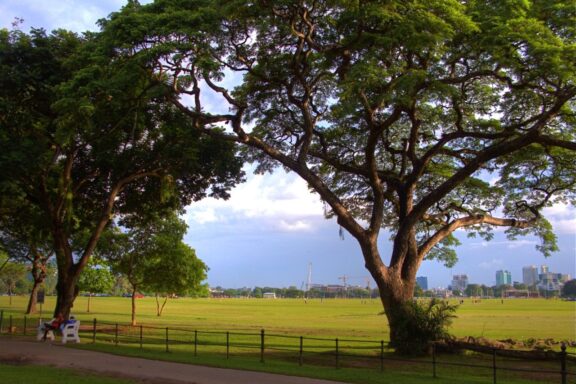
Queen’s Park Savannah serves as the city’s green lung, offering a vast expanse of open space amid the urban environment. A central location for public events, sports, and relaxation, this massive roundabout is a testament to the city’s transformation from a colonial sugar plantation town.
Whether it’s to take a leisurely walk, picnic, or people-watch, there is something for everyone. Additionally, several events and concerts are often held here, making it a central location for experiencing the local culture firsthand.
2. The Magnificent Seven Houses
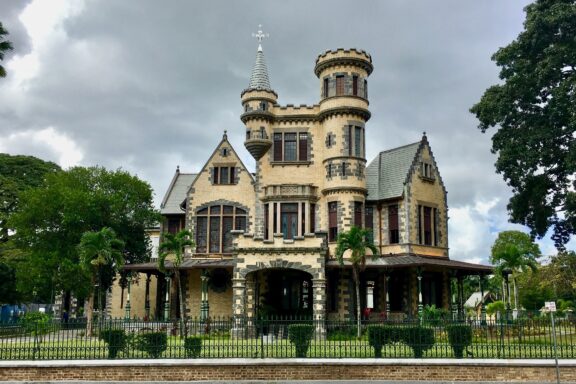
Stollmeyer’s Castle is part of a collection of opulent residences known as the Seven Magnificent Houses. Designed by Scottish architects and built in the early 20th century, each house exudes grandeur and elegance, capturing the imagination of every passerby.
Tourists can marvel at the stunning architecture and can sometimes gain access to the interior during special events or open-house days. While at the site, visitors may also want to explore the other Six Magnificent Houses, each with its unique style and history.
3. National Museum and Art Gallery
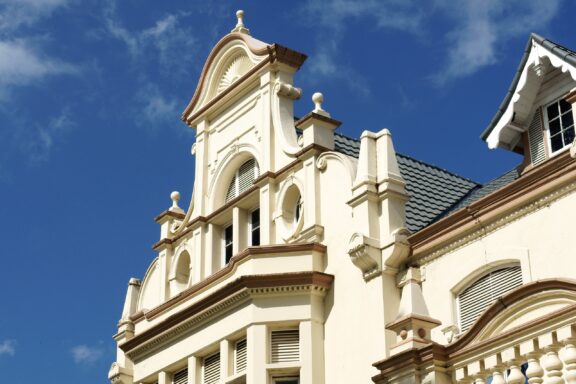
The National Museum and Art Gallery is home to various exhibitions that span natural history, fine arts, and social history. The museum offers a wide array of collections, from indigenous artifacts to contemporary art pieces.
Visiting here is an educational journey through the island’s past and present. Guided tours are often available, and interactive exhibits provide a hands-on experience for younger visitors.
4. Botanical Gardens
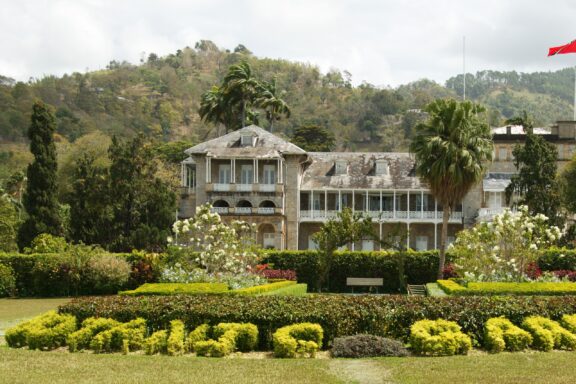
The Botanical Gardens covers a large area and is meticulously maintained. Its paths wind through stands of exotic plants, trees, and flower beds that attract both botany enthusiasts and those simply seeking serenity.
Visitors here can expect a peaceful retreat from the city’s hustle. Apart from walking and enjoying the scenery, it’s also a popular spot for bird-watching. Guided tours are available for those interested in learning about the flora.
5. Maracas Bay
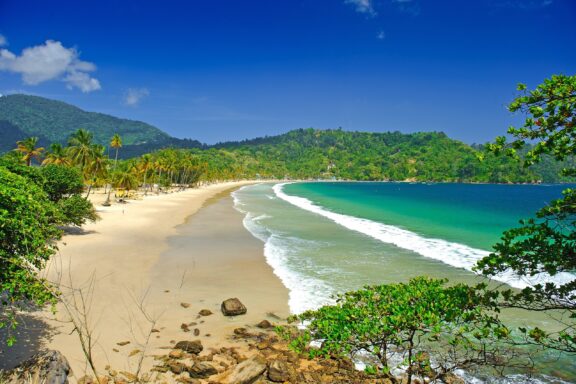
A haven for beachgoers and foodies alike, Maracas Bay is more than just a pretty seascape. It offers the quintessential Trinidadian beach experience with warm waters and local culinary delights.
Lush hills flank the bay, and its sandy shores are the perfect backdrop for sunbathing or swimming. A line of local eateries is situated along the coast, most famous for their “bake and shark.”
6. Fort George
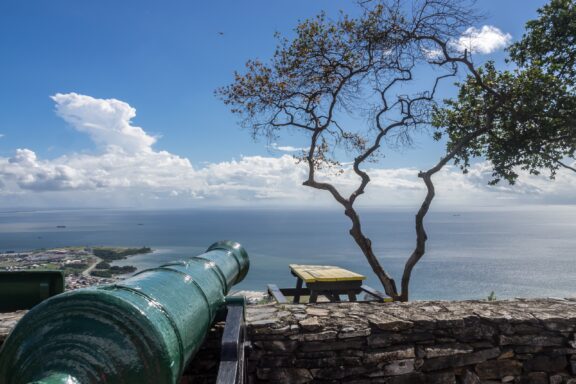
Perched atop a hill overlooking Port of Spain, Fort George is a relic of colonial-era military strategy and a vantage point offering breathtaking views.
Forge George has a complex of historic buildings and fortifications, including the old barracks and several cannons. It is a tribute to the island’s complex colonial past and its role in regional geopolitics.
7. The Cathedral of the Immaculate Conception
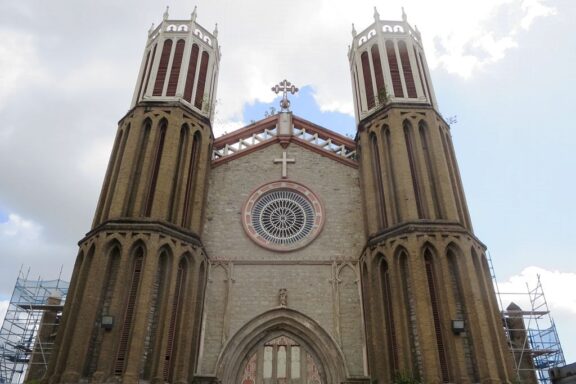
This imposing cathedral is a landmark of religious history and architectural grandeur in Port of Spain. It stands as a testament to the deep-rooted influence of Roman Catholicism in Trinidad and Tobago.
The cathedral’s façade is a captivating mix of styles, combining Gothic and Romanesque architectural elements. Its interiors are awe-inspiring, with elaborate altars, stained glass, and religious artifacts.
8. Chaguaramas Boardwalk
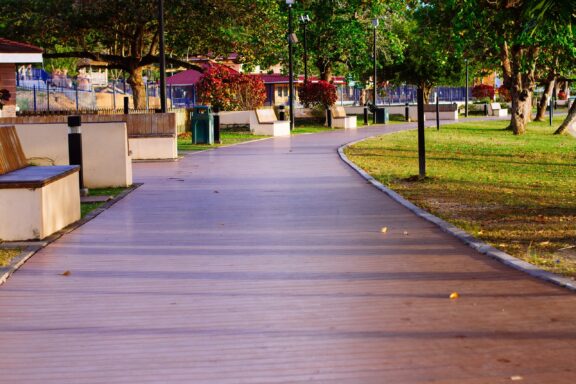
The Chaguaramas Boardwalk is a relatively modern addition to Trinidad’s array of attractions, providing a blend of leisure, natural beauty, and opportunities for outdoor activities.
Ideal for a casual stroll, a jog, or a family outing, the boardwalk also has restaurants and cafes nearby, perfect for a meal with a view. Water sports and boat trips are also accessible from this area.
Frequently Asked Questions
How do I get around the city?
Public transportation is available via buses and shared taxis called “maxi-taxis.” Private taxis and ride-sharing services are also options.
Is Port of Spain safe for tourists?
It’s essential to approach safety in Port of Spain with nuance. While the city has areas considered safe and with relatively low crime rates, it also has neighborhoods where criminal activity, including shootings, is higher.
Solo female travelers and tourists generally can have a secure experience if they take the necessary precautions.
What is the traditional cuisine like in Port of Spain?
The traditional cuisine in Port of Spain is a blend of various influences, including African, Indian, and European culinary traditions.
The city’s history of colonial rule and immigration has shaped a unique food culture with a mix of spices, flavors, and cooking techniques. Ingredients like coconut, curry, and hot peppers are commonly used, making the cuisine rich and diverse.
What are must-try authentic local dishes in Port of Spain?
If you find yourself in Port of Spain, there are some dishes you absolutely must try:
1. Roti: A flatbread often filled with curried meat or vegetables.
2. Doubles: A street food made of spicy chickpeas sandwiched between two pieces of fried dough.
3. Bake and Shark: Fried shark meat served in a fried bun, commonly enjoyed at the beach.
4. Callaloo: A creamy stew made from dasheen leaves, okra, and often, crab or other seafood.
Is it expensive to live in Port of Spain?
The cost of living in Port of Spain can vary, but it is generally considered moderate to high, especially compared to other Caribbean cities. Housing, transportation, and dining expenses can add up, particularly in more upscale neighborhoods.
How long do you live in Port of Spain to become a citizen?
Becoming a citizen of Trinidad and Tobago is not determined by the duration of residence in Port of Spain specifically but rather by national immigration laws. Generally, one can apply for naturalization after residing in the country for at least five years, subject to other legal requirements and procedures.
What shopping options are available?
From high-end malls like West Mall to local markets, shopping in Port of Spain offers a variety of options.
Can I use US dollars, or should I exchange currency?
While some places may accept U.S. dollars, using the local currency, Trinidad and Tobago dollars, is generally better for transactions.
Final Thoughts
Port of Spain offers a rich tapestry of experiences, making it a compelling destination for travelers. Whether you’re drawn by its historical landmarks, cultural diversity, or the natural beauty surrounding it, the city has something for everyone.
From the pulsating energy of its world-famous Carnival to the serene landscapes of nearby beaches and gardens, Port of Spain encapsulates the spirit of Trinidad and Tobago.
Image Sources and Copyright Information
- Map of Trinidad and Tobago: © Peter Hermes Furian/Shutterstock
- Map Highlighting the Location of Port of Spain in Trinidad and Tobago: © PredragLasica/Shutterstock
- Gothic Cathedral Against Blue Sky: © Homo Cosmicos/Shutterstock
- Historic School Building with Clock Tower: © Anton_Ivanov/Shutterstock
- Red Colonial Building Facade Under Blue Sky: © Nandani Bridglal/Shutterstock
- Port of Spain Skyline and Waterfront: © lidian Neeleman/Shutterstock
- Revelers Walking on Street After Carnival Celebration: © Blacqbook/Shutterstock
- Waterfront with Modern Buildings and Moored Ship: © Nandani Bridglal/Shutterstock
- Trees Overlooking a Grassy Field with City Skyline in the Distance: © Georgia Popplewell/Flickr
- Victorian Style Mansion with Turrets: © Lance RF/Shutterstock
- Facade of a Classic Museum Building: © Salim October/Shutterstock
- Presidential House Behind Botanical Garden: © Altrendo Images/Shutterstock
- Tropical Beach with Lush Greenery: © Shameel Hosein/Shutterstock
- Cannon Overlooking Coast from Fort George: © Gail Johnson/Shutterstock
- Cathedral Facade Against Cloudy Sky: © David Stanley/Flickr
- Boardwalk in Chaguaramas at Twilight: © pansticks/Shutterstock